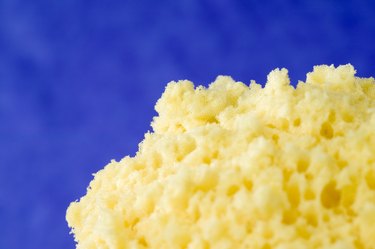Things You'll Need
Bowls or plates
Water or turpentine and linseed oil

Canvas painting is not limited to paintbrushes. You can experiment with various tools such as palette knives or sponges to create different effects. The sponge-painting technique is used in wall painting or when you decorate a three-dimensional sculpture, because a sponge allows you to get paint in hard-to-reach places. In canvas painting, the sponge technique adds depth to your composition and creates textured effects. These effects can work as a background for your painting, but you may also create an entire composition using solely sponges.
Step 1
Prepare liquid colors in ceramic or plastic bowls or plastic plates so you can dip the sponges in them. Get a bowl or plate for each color you want to use. You may use both water-based and oil colors for sponge painting. Dilute water-based colors with water using equal amounts of paint and water. Dilute oil colors using a solution of 50 percent linseed oil and 50 percent turpentine.
Video of the Day
Step 2
Paint your background in one or several colors because the background is visible under the spotted texture you create using sponges. Select the areas where you want to apply the sponge textures.
Step 3
Wet a sponge in water and wring it thoroughly. If using oil paints, use a dry sponge. Dip the sponge in a color and blot it on a piece of newspaper to remove the excess paint. Test the sponge on a piece of paper or newspaper to see the effects it creates. Gently press the sponge on the canvas. Lift the sponge from the canvas and press it again next to the first sponge print you created. You will obtain a spotted effect. Cover the selected areas in sponge texture and allow the background to show through. Rinse the sponge or dip a new sponge in a different color if you want to apply a differently colored texture.
Step 4
Dip the edge of a dry square or rectangular sponge into color and press it against your canvas to create lines in your painting. The sponge should be dry so it is stiff.
Step 5
Paint elements in your composition using sponges. Sketch the elements of your composition on the background using a pencil. Use sponges dipped in various colors to paint over the sketch.
Step 6
Cut your sponges in different shapes, dip these in paint and print your canvas with these shapes.
Tip
Avoid soaking the sponge in color, because a soaked sponge will typically leave a trace in a solid color and you won't obtain the spotted effect. If the sponge is saturated with color, wring it before you continue. Vary the pressure you apply on the sponge when you press it against the canvas to obtain different textures.
Video of the Day